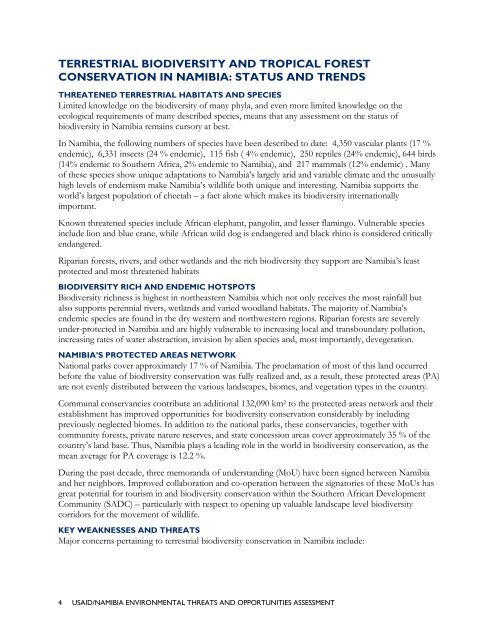usaid/nambia environmental threats and opportunities assessment
usaid/nambia environmental threats and opportunities assessment
usaid/nambia environmental threats and opportunities assessment
You also want an ePaper? Increase the reach of your titles
YUMPU automatically turns print PDFs into web optimized ePapers that Google loves.
TERRESTRIAL BIODIVERSITY AND TROPICAL FOREST<br />
CONSERVATION IN NAMIBIA: STATUS AND TRENDS<br />
THREATENED TERRESTRIAL HABITATS AND SPECIES<br />
Limited knowledge on the biodiversity of many phyla, <strong>and</strong> even more limited knowledge on the<br />
ecological requirements of many described species, means that any <strong>assessment</strong> on the status of<br />
biodiversity in Namibia remains cursory at best.<br />
In Namibia, the following numbers of species have been described to date: 4,350 vascular plants (17 %<br />
endemic), 6,331 insects (24 % endemic), 115 fish ( 4% endemic), 250 reptiles (24% endemic), 644 birds<br />
(14% endemic to Southern Africa, 2% endemic to Namibia), <strong>and</strong> 217 mammals (12% endemic) . Many<br />
of these species show unique adaptations to Namibia’s largely arid <strong>and</strong> variable climate <strong>and</strong> the unusually<br />
high levels of endemism make Namibia’s wildlife both unique <strong>and</strong> interesting. Namibia supports the<br />
world’s largest population of cheetah – a fact alone which makes its biodiversity internationally<br />
important.<br />
Known threatened species include African elephant, pangolin, <strong>and</strong> lesser flamingo. Vulnerable species<br />
include lion <strong>and</strong> blue crane, while African wild dog is endangered <strong>and</strong> black rhino is considered critically<br />
endangered.<br />
Riparian forests, rivers, <strong>and</strong> other wetl<strong>and</strong>s <strong>and</strong> the rich biodiversity they support are Namibia’s least<br />
protected <strong>and</strong> most threatened habitats<br />
BIODIVERSITY RICH AND ENDEMIC HOTSPOTS<br />
Biodiversity richness is highest in northeastern Namibia which not only receives the most rainfall but<br />
also supports perennial rivers, wetl<strong>and</strong>s <strong>and</strong> varied woodl<strong>and</strong> habitats. The majority of Namibia’s<br />
endemic species are found in the dry western <strong>and</strong> northwestern regions. Riparian forests are severely<br />
under-protected in Namibia <strong>and</strong> are highly vulnerable to increasing local <strong>and</strong> transboundary pollution,<br />
increasing rates of water abstraction, invasion by alien species <strong>and</strong>, most importantly, devegetation.<br />
NAMIBIA’S PROTECTED AREAS NETWORK<br />
National parks cover approximately 17 % of Namibia. The proclamation of most of this l<strong>and</strong> occurred<br />
before the value of biodiversity conservation was fully realized <strong>and</strong>, as a result, these protected areas (PA)<br />
are not evenly distributed between the various l<strong>and</strong>scapes, biomes, <strong>and</strong> vegetation types in the country.<br />
Communal conservancies contribute an additional 132,090 km 2 to the protected areas network <strong>and</strong> their<br />
establishment has improved <strong>opportunities</strong> for biodiversity conservation considerably by including<br />
previously neglected biomes. In addition to the national parks, these conservancies, together with<br />
community forests, private nature reserves, <strong>and</strong> state concession areas cover approximately 35 % of the<br />
country’s l<strong>and</strong> base. Thus, Namibia plays a leading role in the world in biodiversity conservation, as the<br />
mean average for PA coverage is 12.2 %.<br />
During the past decade, three memor<strong>and</strong>a of underst<strong>and</strong>ing (MoU) have been signed between Namibia<br />
<strong>and</strong> her neighbors. Improved collaboration <strong>and</strong> co-operation between the signatories of these MoUs has<br />
great potential for tourism in <strong>and</strong> biodiversity conservation within the Southern African Development<br />
Community (SADC) – particularly with respect to opening up valuable l<strong>and</strong>scape level biodiversity<br />
corridors for the movement of wildlife.<br />
KEY WEAKNESSES AND THREATS<br />
Major concerns pertaining to terrestrial biodiversity conservation in Namibia include:<br />
4 USAID/NAMIBIA ENVIRONMENTAL THREATS AND OPPORTUNITIES ASSESSMENT

















